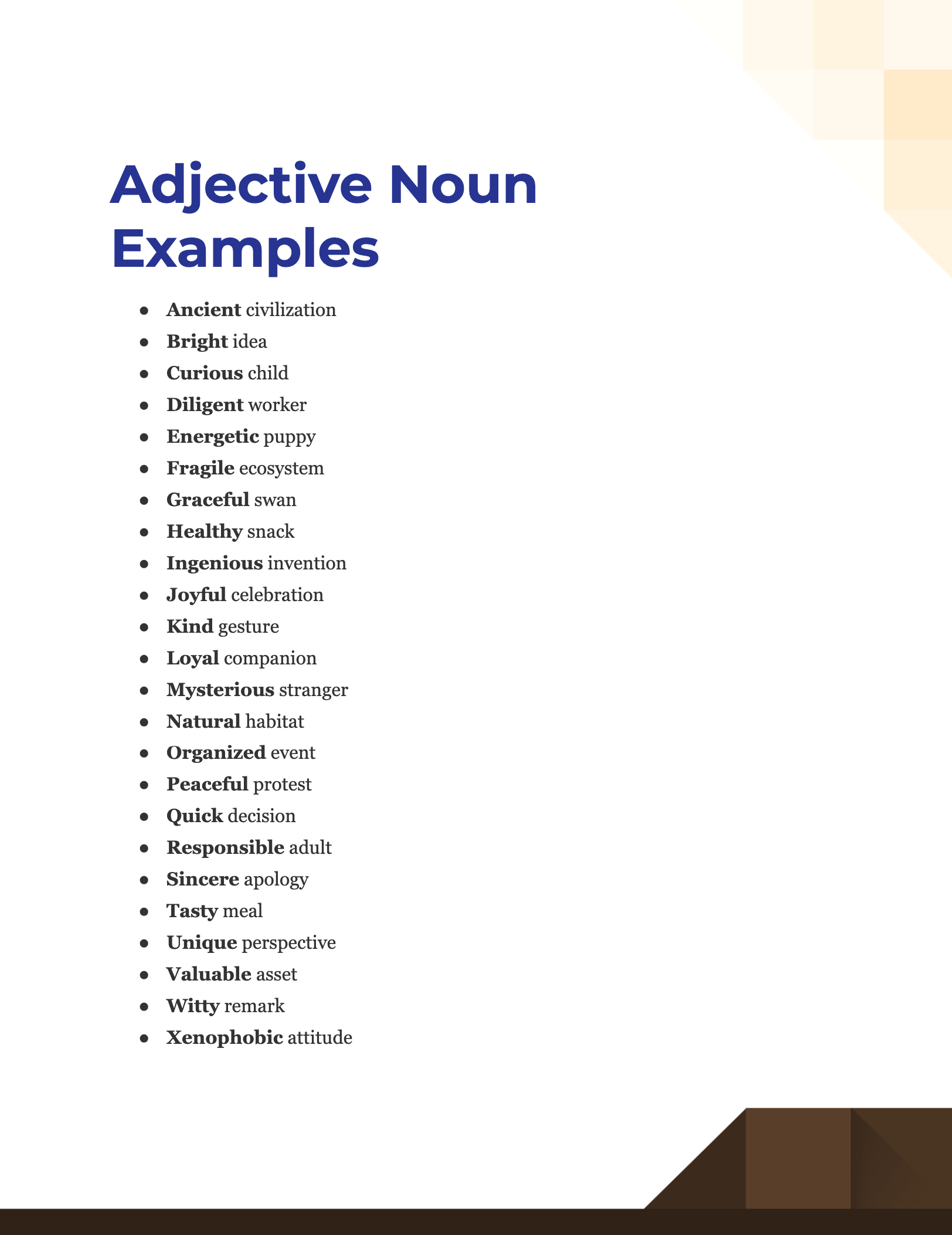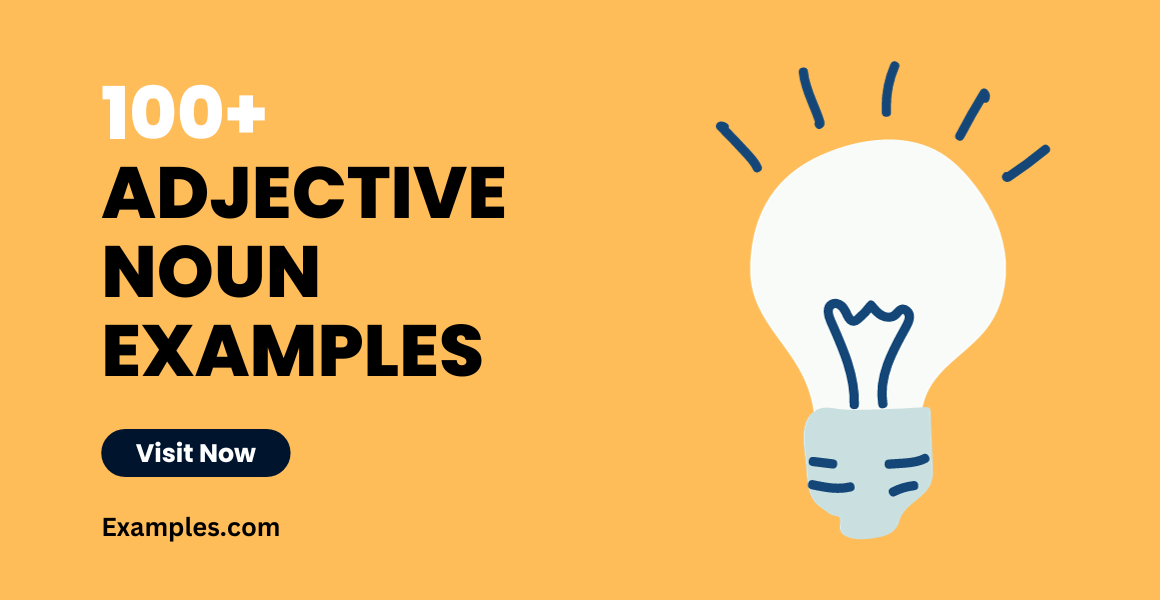99+ Adjective Noun Examples
Understanding the correct way to pair adjectives and nouns can significantly improve your English. In this guide, you’ll find exclusive tips, along with adjective examples to clarify how adjectives and nouns work together to form more descriptive and meaningful sentences.
What is the Adjective Noun Combo? – Definition
An adjective-noun combo is a pair consisting of an adjective that modifies or describes a noun. For instance, in the term “happy child,” “happy” is the adjective and “child” is the noun.
What is the Best Example of an Adjective-Noun Combo?
The best example would be “graceful dancer.” Here, “graceful” perfectly describes the quality of the “dancer,” making the term highly illustrative.
100 Adjective Noun Examples

Unleash the expressive power of the English language by mastering adjective-noun combinations. These pivotal linguistic duos allow for rich and nuanced descriptions, elevating your writing and conversations. Improve your vocabulary and discover how these pairings can make your language more engaging and effective. Here are 100 unique, handpicked examples.
- Ancient civilization
- Bright idea
- Curious child
- Diligent worker
- Energetic puppy
- Fragile ecosystem
- Graceful swan
- Healthy snack
- Ingenious invention
- Joyful celebration
- Kind gesture
- Loyal companion
- Mysterious stranger
- Natural habitat
- Organized event
- Peaceful protest
- Quick decision
- Responsible adult
- Sincere apology
- Tasty meal
- Unique perspective
- Valuable asset
- Witty remark
- Xenophobic attitude
- Youthful energy
- Zealous supporter
- Adventurous explorer
- Brilliant scientist
- Calm lake
- Delicious food
- Eager student
- Fearful expression
- Generous donation
- Humble abode
- Incredible feat
- Jovial mood
- Keen observer
- Luminous object
- Magnificent view
- Nurturing environment
- Opulent mansion
- Proud parent
- Quiet place
- Rambunctious crowd
- Steady hand
- Thrilling adventure
- Uplifting story
- Vigorous exercise
- Wise elder
- Exquisite taste
- Young athlete
- Zany comedian
- Artistic flair
- Boisterous laughter
- Creative mind
- Determined individual
- Efficient system
- Glamorous lifestyle
- Harmonious relationship
- Intuitive person
- Judicious choice
- Knowledgeable expert
- Lethargic sloth
- Musical talent
- Nostalgic moment
- Obedient dog
- Persistent effort
- Quirky habit
- Radiant smile
- Sophisticated algorithm
- Tenacious advocate
- Unpredictable weather
- Versatile actor
- Wondrous sight
- Xeric landscape
- Yielding plant
- Zealot group
- Affectionate embrace
- Blissful marriage
- Cautious investor
- Dynamic duo
- Eccentric personality
- Fleeting moment
- Gracious host
- Hazardous chemical
- Idealistic dreamer
- Jubilant crowd
- Knavish trick
- Logical argument
- Majestic mountain
- Nebulous concept
- Outrageous claim
- Picturesque scenery
- Quaint village
- Rebellious teen
- Serene beach
- Turbulent waters
- Unassuming manner
- Volatile compound
- Whimsical art
Adjective Noun Sentence Examples
Adjective-noun combinations can be a powerful tool in both written and spoken English. They add depth and specificity, enriching the text and making it more engaging for readers. Whether you’re writing blog posts, research papers, or simply texting, knowing how to pair adjectives and nouns effectively can elevate your language skills.
- The meticulous student revised her paper several times before submitting it.
- The brave firefighter rushed into the burning building.
- She wore a gorgeous dress to the evening gala.
- A loyal dog will always stick by its owner.
- He gave a rousing speech at the company meeting.
- Her haunting melody stayed with me long after the concert.
- The furious wind knocked over several trees.
- She had a genuine smile that could light up a room.
- The ravenous wolf hunted down its prey.
- He made an impressive jump during the track and field event.
Adjective Noun Compound Words Examples
Adjective-noun compound words are fascinating elements of the English language. They are words where an adjective and a noun combine to form a single term, often with a unique meaning. These compounds can add punch to your writing and help you convey complex ideas with simple words.
- The highchair is only for toddlers.
- A toothbrush is essential for good dental hygiene.
- She always orders blackcoffee.
- We need to buy a bedsheet.
- He read a storybook to his daughter before bed.
- The greenhouse is full of exotic plants.
- Her toothpaste was mint-flavored.
- The mailbox was full of letters.
- I forgot my password again.
- They took the shortcut to reach their destination faster.
How Do You Use Adjective Nouns?
Using adjective-noun combinations effectively can be a game-changer for your writing. These pairings add nuance and specificity to your sentences, making your content more engaging and understandable. Here’s a step-by-step guide to using adjective nouns proficiently:
- Identify the Noun: Start by identifying the noun you want to describe. Is it a person, place, thing, or idea?
- Choose the Right Adjective: Pick an adjective that accurately describes the noun in question. Make sure it enhances the sentence without being redundant.
- Placement: Typically, the adjective comes before the noun in English. For instance, “happy” comes before “child” in “happy child.”
- Avoid Overuse: Too many adjectives can clutter your sentence. Stick to one or two for clarity unless additional descriptors are absolutely necessary.
- Match in Number and Tense: If the noun is plural, make sure your adjective does not change. Unlike some other languages, adjectives in English stay the same whether the noun is singular or plural.
- Check Compatibility: Ensure that the adjective and noun are compatible in terms of what they describe. For example, it’s more appropriate to say “speedy runner” than “speedy snail.”
- Test the Sentence: After placing the adjective and noun together, read the sentence aloud to ensure it sounds natural and conveys the intended meaning.
Example Sentences:
- The enthusiastic audience clapped loudly.
- She wore a beautiful gown.
What Is an Adjective and Noun Together?
An adjective-noun combination is when an adjective, which describes or modifies a noun, is paired with a noun to offer more information about it. The adjective usually precedes the noun and gives the reader or listener a better understanding of the object, place, or person being described. For example, in the phrase “red apple,” “red” is the adjective and “apple” is the noun. Together, they offer a more specific image than the noun alone.
These combinations are ubiquitous in the English language and are essential for creating vivid, detailed descriptions. They are used across various forms of writing and speaking, from formal essays and reports to everyday conversations.
Examples for Understanding:
- Strong wind: Here, “strong” is the adjective that describes the noun “wind.”
- Happy family: In this case, “happy” is the adjective that tells us more about the “family.”
Mastering the use of adjective-noun combinations can significantly enrich your vocabulary and elevate the quality of your writing, making it more appealing to readers.
How to Use an Adjective and a Noun: A Comprehensive Guide
Combining an adjective with a noun is an art form that can significantly enhance the impact of your language. Whether you’re writing an article, a book, or simply conversing, here’s how to ace the pairing:
- Spot the Noun: Pinpoint the noun you wish to embellish. This could be a person, a location, an object, or even an abstract concept.
- Pick Your Adjective: Opt for an adjective that vividly and accurately paints a mental picture of your noun. Make sure the adjective amplifies the noun’s attributes effectively.
- Proper Sequencing: In most cases, place the adjective before the noun for a natural flow. For example, say “scrumptious pizza” as opposed to “pizza scrumptious.”
- Relevance Check: Assure that your adjective and noun are a coherent match. Mismatched pairs can lead to ambiguity.
- Less is More: Avoid an overload of adjectives. A single, well-chosen adjective often does the job more efficiently than a bunch of them.
- Oral Test: Pronounce your sentence to ensure it rolls off the tongue and delivers the impact you intended.
- Refine and Revise: Scrutinize your sentence to check if the adjective-noun pairing can be further improved or simplified.
Tips for Mastering Adjective-Noun Pairings
- Opt for Precision: Choose adjectives that are as specific as possible. Vague descriptors like “nice” or “big” usually fall flat.
- Harmony is Key: Don’t stuff your sentence with multiple adjectives; this can be overwhelming and counterproductive.
- Essentiality Test: Remove the adjective and re-read your sentence. If the essence remains unaltered, you probably don’t need that adjective.
- Order Matters: If you absolutely must use multiple adjectives, remember to place them in the standard sequence: quantity, quality, size, age, shape, color, origin, material, then purpose.
- Style Consistency: Ensure that the tone of your adjectives matches the overall tone of your content.
- Invoke Sensory Experience: Use adjectives that appeal to the senses for a more immersive reader experience.
- Thesaurus is Your Friend: Don’t be afraid to consult a thesaurus for better adjective options, as variety can add spice to your writing.
By judiciously choosing and placing adjectives next to nouns, you can elevate your writing, making it not only more informative but also more captivating for your readers.



